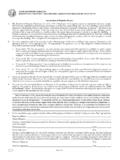Transcription of Excreta disposal - World Health Organization
1 38 CHAPTER 4 Excreta disposalSafe disposal of Excreta , so that it does not contaminate the environment,water, food or hands, is essential for ensuring a healthy environment and forprotecting personal Health . This can be accomplished in many ways, somerequiring water, others requiring little or none. Regardless of method, the safe disposal of human faeces is one of the principal ways of breaking thefaecal oral disease transmission cycle. Sanitation is therefore a critical barrierto disease for locating sanitation facilities, and for treating and removingwaste, must consider cultural issues, particularly as sanitation is usuallyfocused on the household. Excreta disposal may be a difficult subject for acommunity to discuss: it may be taboo, or people may not like to discussissues they regard as personal and unclean. In some cases, people may feelthat sanitation facilities are not appropriate for children, or that children sfaeces are not harmful.
2 In others, separate facilities may be required for menand women, and it may be necessary to locate the facilities so that no one canbe seen entering the latrine building. If the disposal facilities smell and are abreeding ground for flies, people may not use improvement comes from the proper use of sanitation facilities, notsimply their physical presence, and they may be abandoned if the level ofservice does not meet the social and cultural needs of community membersat an affordable cost, as shown in Figure Within a community, several different sanitation options may be required, with varying levels of conveni-ence and cost (sometimes called a sanitation ladder). The advantage of thisapproach is that it allows households to progressively upgrade sanitationfacilities over for Excreta disposalTechnologies for Excreta disposal , with illustrations, are briefly discussedbelow. More detailed information is provided in the references cited in Annex is the most basic form of Excreta disposal faeces are collected in acontainer and disposed of daily.
3 An example is the bucket latrine, in whichhousehold wastes are collected in buckets under a hole in the floor of a specific room. Each day, the bucket is emptied into a larger container and thecontents disposed of. Bucket latrines should not be promoted because theypose Health risks to both users and collectors and may spread disease. Ifcartage is considered for your community, a vault latrine (a latrine wherewastes are stored in a sealed container) that is mechanically emptied on aregular basis is a better 4. Excreta DISPOSAL39 Figure latrinesIn most pit latrine systems, faecal matter is stored in a pit and left to decom-pose. Unless specifically designed, pit latrines do not require periodic emp-tying; once a pit is full it is sealed and a new pit dug. If faecal matter is leftto decompose in dry conditions for at least two years, the contents can besafely emptied manually and the pit reused.
4 Indeed, some pit latrines aredesigned to allow faecal matter to compost and be reused in designs use two alternating pits, reducing the need for new pits. Somepit designs are meant to be completely dry, while some use small quantitiesof water. Ventilation to remove odours and flies is incorporated into certaindesigns, while others are very basic and use traditional materials andapproaches. As with all sanitation designs, it is important to know what com-munity members want and can pay for before embarking on construction. Anexample of an improved pit latrine is shown in Figure sanplat is the cheapest and most basic pit latrine. It is a small concreteplatform (usually 60 cm 60 cm or smaller), laid on top of logs or other sup-porting material traditionally used to cover the pit. The purpose of the sanplatis to provide a sanitary (san) platform (plat) which can be easily cleaned tolimit the presence of helminths such as hookworm.
5 Once the pit is full, thesanplat can easily be moved. However, the sanplat design does not overcomeproblems with odours or flies and may not be acceptable to some communitymembers. The sanplat is best used when there is very little money for improv-ing sanitation and where odours and flies will be VIP latrineThe VIP (ventilated improved pit) latrine is designed to overcome some ofthe problems with traditional latrine designs, but it is more expensive than asanplat. It has a vent pipe from the pit to above the roof of the building asshown in Figures and When air flows across the top of the vent pipe,air is drawn up the pipe from the pit and fresh air is drawn into the pit fromthe building. Offensive odours from the pit thus pass through the vent pipeand do not enter the building. The location of VIP latrines is important: unlessa clear flow of air is maintained across the top of the vent, the ventilationsystem may not be effective.
6 VIP latrines should therefore be located awayfrom trees or high buildings that may limit airflow. A dark vent pipe alsohelps the air to rise. The top of the pipe is usually covered with mosquitomeshing. If the inside of the building is kept partially dark, the flies will beattracted to light at the top of the pipe, where they will be trapped and VILLAGES: A GUIDE FOR COMMUNITIES AND COMMUNITY Health WORKERSWhen the VIP latrine is constructed and used properly, it provides greatimprovements in fly and odour control, but may not eliminate VIP latrine is designed to work as a dry system, with any liquid in thecontent infiltrating into the surrounding soil. Although some liquid inevitablywill enter the pit, it should be minimized. For example, it would not be appro-priate to dispose of household wastewater into the pit as this may preventdecomposition of the contents. VIP latrines are most appropriate wherepeople do not use water for cleaning themselves after defecating, but use solidmaterials such as paper, corncobs or 4.
7 Excreta DISPOSAL41 Figure pit latrine42 HEALTHY VILLAGES: A GUIDE FOR COMMUNITIES AND COMMUNITY Health WORKERSF igure latrineFigure pit latrineVIP latrines may be designed with single or double pits. Double pits maybe used, for example, when cultural taboos prohibit the mixing of male andfemale faeces. Twin pits may also be used to facilitate emptying and com-posting. When one pit is full, the other can be emptied and reused. The pitof a VIP latrine is usually located directly beneath the slab to prevent foulingof the chute, which would lead to odour and fly problems, and require VIP latrine is more expensive than either traditional designs or thesanplat and this should be borne in mind when considering its use. In someareas, traditional latrines or sanplat latrines can be improved by providingventilation. However, it likely that traditional floor materials will allow lightto enter the pit, which will make fly control more difficult.
8 Installing a ventpipe on an existing latrine may damage it. When considering a VIP latrine asan improvement on existing sanitation, it is important to be aware that thismay require the construction of a new latrine, not simply the upgrading ofan existing flush latrinesA pour flush latrine is a type of pit latrine where small volumes of water (commonly 1 3 litres) are used to flush faeces into the pit. They are mostappropriate where people use water to clean themselves after defecating( in Muslim cultures) and where people have access to reliable water supplies close to the home. Solid materials should not be disposed of intopour flush latrines, as this could block the pipe and even cause it to pour flush latrine has a small collection pan set in a slab. Wastes are dis-posed of through a section of pipe bent into a U shape (a U-bend) to maintaina water seal for reducing fly and odour problems.
9 A vent pipe may also beadded to the pit to help with fly and odour problems. The pit of a pour flushlatrine may be located directly beneath the slab or set to one side, but offsetpits may require more water to prevent blockages. The pit is usually connectedto a soakaway to allow liquids to infiltrate the soil, leaving solid waste todecompose. Pour flush latrines can also be designed to be connected to small-bore sewers at a later date. As with VIP latrines, twin pits may be tanksA septic tank is a form of on-site sanitation that provides the convenience ofa sewerage system. It is usually linked to flush toilets and can receive domes-tic wastewater (or sullage). Since flush toilets tend to use large amounts ofwater, septic tanks are usually appropriate only for households with waterpiped into the home. The tank is offset from the house and linked to the toiletCHAPTER 4. Excreta DISPOSAL43and domestic wastewater by a short drain.
10 It is designed to hold solids andis linked to a soakaway to dispose of liquid waste (effluent). septic tanks generally require relatively large amounts of land and peri-odic emptying by vacuum tankers. This is often expensive and the trucks will need easy access to the tank. septic tanks thus tend to be high-cost solutions for improving sanitation. They are commonly used only by com-munities whose members have access to water supply within the home,have land available and who can afford the cost of emptying the tanks . Com-munal septic tanks may be feasible if a large number of households close tothe tank can be connected with very short lengths of sewer pipe. For such asystem to work, however, each household needs sufficient water to flushfaeces into the septic tank effectively. This approach will probably be effec-tive only when water is supplied to at least one tap on each aquaprivy is similar to a septic tank; it can be connected to flush toiletsand take most household wastewater.













